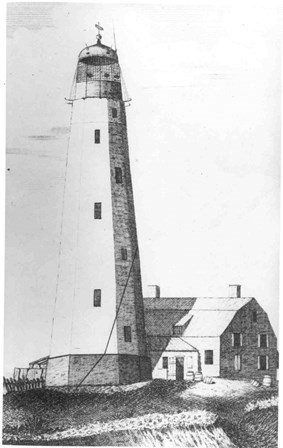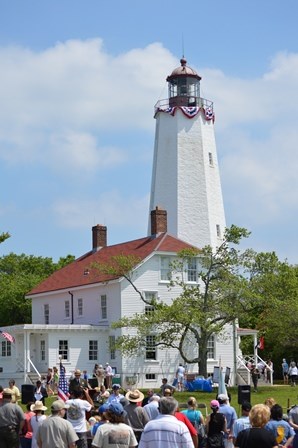
NPS ARCHIVES A "stinking Ediface" that saved lives The Sandy Hook Lighthouse has been lighting the way for sea travelers for more than 250 years. Since 1857 the lighthouse has had a third-order Fresnel (fray-NELL) lens. The lighthouse is now maintained by the U.S. Coast Guard, but for more than a century, wicks had to be trimmed and large containers of whale oil or kerosene needed to be carried up 108 steps. That required a full-time keeper and some assistants. Five lighthouse keepers quarters have been constructed here, the last in 1883. The first keeper lived in a "dwelling house" made of "timber and boards." He could keep two cows on the premises, but could not use the tower as a "public-house for selling strong liquors." Ambrose Serle, secretary to British Admiral Lord Howe during the American Revolution, described Sandy Hook as a "dismal barren spot" and the Lighthouse as "a stinking Edifice, by means of the [whale] oil and the Provincials [Loyalist soldiers, colonists allied with the British] stationed in it." It was no better in 1870, when a New York Times reporter visited: "For all the disagreeable places that a man can be stationed at, to wait for anything, (except grim death,) Sandy Hook is the meanest... place on the footstool... more mosquitoes and flies have been bred here than in any place of the same size on the American Continent..." ![C.W. Patterson and Sarah Patterson Johnson, the brother-sister team that ran the Lighthouse. Sarah wrote to her father, "...I get homesick... We can't hardly tell whether its spring or not... [because] the sand and cedars never change."](/gate/learn/historyculture/images/CW-and-Sarah-Johnson-WS.jpg?maxwidth=650&autorotate=false)
NPS ARCHIVES, courtesy of the Johnson family Charles W. Patterson and Sarah Johnson: Brother-sister team On March 21, 1861, Charles W. Patterson replaced Uriah Smalley as appointed keeper of the Sandy Hook Lighthouse, a position he would keep for 24 years. Frank and Austin Patterson served as assistant keepers. While living and working at Sandy Hook, Charles and his wife, W. Anker Patterson, raised three sons: Trevonian H., Franklin and Edwin Statton, and a daughter, Mary. Trevonian would later serve 30 years at U.S. Life-Saving Service (USLSS) Station Number 1 at Sandy Hook beginning in 1878. Franklin worked with the USLSS for four years, from 1888-1892. Charles' sister Sarah Patterson Johnson was hired as assistant in May 1867, replacing possible relative Frank Patterson. She worked alongside Samuel P. Jewell, who was also hired as assistant keeper two years later. Maintaining the light required a lot of care. The flame needed to burn brightly in all kinds of weather. To maintain the flame---and the Fresnel lens---assistants and keepers had to climb 108 steps multiple times a day. The lamp needed to be filled with kerosene oil, which had to be taken upstairs. When Charles, ill with Bright's disease, resigned in 1885, so did Sarah. However, Sarah remained at Sandy Hook--with its unchanging sand and cedar--to teach the children of soldiers at the public school located in the Sandy Hook Proving Ground. She remained there until 1898, when the Army ordered all civilians off the peninsula due to the Spanish-American War. Sarah returned to her hometown of Howell, N.J., where she died in 1909. Samuel P. Jewell: The changing landscape of Sandy Hook When Charles Patterson retired, Jewell was promoted to lighthouse keeper. He had lived in separate but adjoining quarters next to Charles with his own family. He and his wife, Emma (or Emily) Patterson Megill, raised their son Arthur and daughter Bertha. A niece, Susan Greives, lived with them as a child as well. He had several assistants over the years; the last, Howard Poe, ultimately succeeded him. The Sandy Hook Proving Ground was established in 1874. Living next to an Army proving ground forever changed the serenity of the Hook. Would shock waves from the mortar battery shatter the glass prisms in the Fresnel lens? That did not happen, but when a mortar blew up in July 1903, 15 tons of metal rained down "all over the Hook," destroying Jewell's bicycle. The lighthouse was first electrified in 1894, thanks to its proximity to the electrically lit Gedley Channel buoys and the North Hook Beacon at the tip of the Hook. When the buoys were converted to gas lighting in 1903, the Sandy Hook Lighthouse reverted to kerosene. That added to Jewell's work load and worsened his health. By March 1909, "Heart trouble for Mr. Jewell had been the result of rushing up those winding stairs, and he is unable to attend to his duties in keeping this important light in working order.... The doctor says he will never get back to duty... again." After having lived at the Hook for 40 years, he apparently needed to move in with friends in Oceanport. Losing his claim for workmen's compensation, he died in 1913. Park staff have never found a photograph of Jewell, the longest-serving lighthouse keeper. 
NPS PHOTO by Allison Luchnick A list of all known keepers of the Sandy Hook Lighthouse In 1925, electricity returned to the lighthouse, this time to stay. Reliable electric power made the position of an on-site lighthouse keeper increasingly obsolete. By 1941, the Lighthouse was in the hands of the U.S. Coast Guard (USCG). Today, the 1000-watt light bulb and Fresnel lens continue to be maintained by USCG and to shine for seafarers near the Hook. Unknown 1764-1783 *appointed by President George Washington |
Last updated: September 29, 2020
